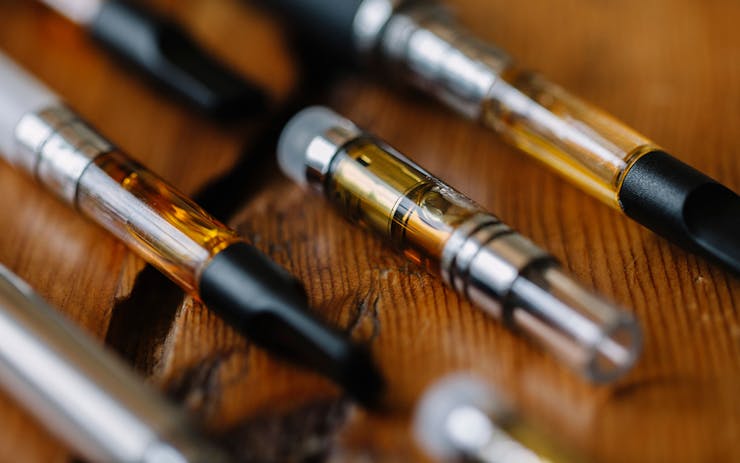Vape pens have revolutionized the way many people consume cannabis, as well as other materials, including nicotine and flavored oils. They are discreet and convenient, allowing you to reap the benefits of cannabis products without needing to roll a joint or use a bulky apparatus.
To activate the cannabinoids—such as CBD and THC—in cannabis, it needs to be heated to 315-465°F. Vape pens do this very quickly, in many cases heating the product to the desired temperature virtually instantly. And there is no fuss involved. All you need to do is press a button—or in some cases, simply inhale—to activate the pen.
While there are different types of vape pens available, such as those specifically for dry herbs or waxes, we’ll focus on the anatomy of a standard 510-threaded vape pen filled with cannabis oil.

(Joshua Titus/Leafly)
A vape pen is comprised of the following main components:
- Mouthpiece
- Tank or cartridge
- Atomizer
- Power button and sensor
- Battery
1. Mouthpiece

(Joshua Titus/Leafly)
The mouthpiece, as expected, is the part that you actually inhale through. These are sometimes called “drip tips” and are often removable and replaceable. They’re typically made from glass, silicone, or plastic, and come in lots of different shapes, sizes, and colors.
2. Tank or cartridge

(Joshua Titus/Leafly)
This is the chamber where the cannabis oil is held. Although the terms “tank” and “cartridge” are often used interchangeably, a cartridge usually refers to a pre-filled vessel, while a tank is a chamber that you can fill with your own oil.
If you’re using a refillable tank, there should be a fill level line to show you how much product to add.
3. Atomizer

(Joshua Titus/Leafly)
The atomizer is where the magic happens as this is where the oil is heated. This component has a heating element nested in a steel or ceramic housing. The element heats the cannabis oil, forming tiny vapor droplets for inhalation.
There are different types of atomizers to choose from, with common types being cotton wick, quartz, and ceramic.
In a cotton wick atomizer, a coil of wire is wrapped around a small cotton wick. The wick is saturated with the oil, which is then heated by the element. The disadvantage to this type of atomizer is that it’s easy to burn the wick, especially when using more viscous oils or higher voltages. Burning results in an unpleasant flavor and requires that the coil be replaced.
Increasingly popular in cannabis oil vape pens, ceramic coils have a wire wrapped around a small ceramic cylinder. These can be used at higher voltages than cotton wick coils and offer good heat retention. Also popular in modern vape pens, quartz coils heat up very quickly. However, they don’t retain heat as well as ceramic coils.
4. Power button and sensor

(Joshua Titus/Leafly)
Some vape pens will have a power button which you press when you want to inhale. This triggers a sensor which kicks the atomizer into action. Others are draw-activated and switch on whenever you inhale.
Those with power buttons often work using a five-click method. You have to press the button five times in quick succession to power it on and another five times to switch it off again. This is designed to help prevent accidental activation of the atomizer as this could harm the vape pen and waste product.
Most vape pens will allow you to cycle through different temperatures with clicks of the button.
5. Battery

(Joshua Titus/Leafly)
The battery has to supply a large amount of power so that the heater can quickly reach a high temperature. Vape pens typically use lithium ion batteries that are rechargeable. These are similar to batteries used in cellphones and electric cars. Some batteries have multiple voltage levels, enabling you to control the temperature of the heating coil.
A standard 510 vape pen comes with a threaded charger that is screwed to the battery end of the pen. The charger will typically have a USB port that can be plugged into the wall using a charging block, or into a computer or other device.





